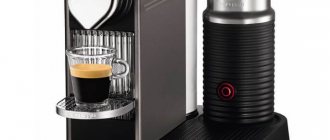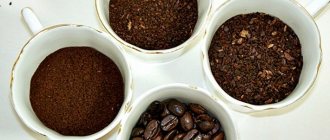The names of most household appliances determine the scope of their use. Thus, a juicer is used to prepare freshly squeezed juice, and a coffee grinder is used to grind coffee beans. Nevertheless, many culinary recipes are replete with phrases like: “...grind 100 g of sugar/black pepper/cereals in a coffee grinder.” Is this household appliance intended for such purposes, and if so, what can be ground in a coffee grinder other than coffee, and what should be avoided, will be described in detail in this material.
What can you grind in a rotary coffee grinder?
The most common option for home use is an electric coffee grinder with rotary, that is, rotating blades. Another name for such a coffee grinder is a knife grinder. This is a fairly simple and compact device, the design of which includes one or two cutting blades. Depending on the price category, they can be either removable or stationary. If you are planning an unintended use that goes beyond the preparation of coffee powder prescribed in the instructions, then it is preferable to opt for the first configuration.
Important! Models with fixed knives are difficult to clean. Therefore, foodies are not advised to use them for anything other than the immediate task. This precaution is due to the tendency for foreign odors to accumulate, as well as food particles stuck in hard-to-reach places. This may not have the best effect on the taste of the future drink.
Principle of operation
The operating principle of rotary coffee grinders is based on the rotational action of steel blades, which are produced at one speed, cutting the coffee beans . In this case, the size of the fraction depends on the exposure time: the longer, the finer. The device is activated by interval pressing of the button on the lid. Thus, you can independently adjust the grinding amount.
However, you should be careful not to burn the coffee, as during prolonged operation the mechanism becomes very hot and can char the contents of the container. This can be determined by the haze emanating from under the lid, as well as the excess bitterness of the brewed coffee.
Alternative uses
As for alternative use, it is not advisable to immerse high-density products in the knife model, such as lump sugar, rock salt huddled in dense piles, as well as certain varieties of legumes. Unlike a millstone, a rotary coffee grinder does not grind food, but cuts it, which allows you to preserve more essential oils and juices. Therefore, this feature should be regarded as an advantage when grinding dried fruits and vegetables, as well as spices.
It should be noted that devices with knives do not allow achieving uniform grinding. On the one hand, this is well suited for the described operations, allowing the flavor of dry fruits to be revealed, but on the other hand, this is unacceptable in the preparation of infant formula, where uniformity is important. This method of grinding will also not be beneficial when it comes to preparing coffee and coffee drinks in special machines.
Among other things, a blade coffee grinder can be used as a blender due to its similar operating principle. Rotary knives are great for whipping purees. The basic rule is not to place large fruits whole. It is better to first cut them into equal pieces.
Grinding rules
To maximize all the benefits of a rotary mill, you should adhere to certain rules.
- It is necessary to work in intervals, alternately pressing and releasing the start button, so as not to burn the food.
- Do not place food that is too hard into the container, as chopping may cause the knives to become dull.
- Rotary coffee grinders use a single container to grind and store the ground product, so you should be careful when removing the resulting substance from the machine - you can injure yourself on the blades.
- Since there is only one container, you cannot store chopped food in it, because the longer it is there, the more odors are absorbed, and the more difficult it is to get rid of them in the future.
- The previous rule especially applies to coffee: the tube of a rotary coffee grinder is not sealed and is not suitable for storage, since the signature aroma quickly evaporates.
- In models of this type, there is no possibility of adjusting the amount of the required substance at the output, so it is better to initially place the raw materials in them in the volume that will be immediately used.
Advice: if a coffee grinder is purchased as a universal tool, then you should consider models with replaceable knives. Ideally, buy two separate devices: one for coffee, the second for everything else.
Zauber Z-490
The Swedish brand offers a unique design and, let's say, acceptable quality. The attractive price of this coffee grinder is ensured by minimal functionality and a flimsy Chinese assembly. I frankly don’t like the quality of the design itself, but let’s see what makes this device remarkable.
Zauber Z-490 is a standard burr-type coffee grinder for the economy class. You'll get a fairly low cup capacity - 90g - but it won't hurt to make a couple of cups of coffee in the morning at a time. The quality of the resulting drink is positively influenced by the grinding degree regulator and ceramic (!) millstones.
The bowls are made of acrylic, and the body is made of food-grade hygienic steel, which is generally not bad, but does not claim to be superior.
What can you grind in a burr coffee grinder?
Its mechanism is based on steel millstones, which rotate towards each other and grind the fruits located between them. In this case, the grind size depends on the distance between the millstones, as well as on the speed of their rotation.
Principle of operation
Depending on the type of millstone, there are two types of coffee grinders.
- Conical. Suitable for home use, as it copes with almost any product without overheating during operation and thereby not “overcooking” them.
- Cylindrical. Higher-class equipment, suitable for professional use due to its increased power. However, this also causes breakdowns associated with overheating of the structure.
The main advantage of burr coffee grinders is the ability to fine-tune them. Manufacturers provide several size modes, which are selected depending on the required product. Their number determines the cost of the device, but on average this figure ranges from 10-15 modes, which is enough for most culinary tasks.
Burr coffee grinders differ from knife grinders in the presence of two separate containers: in one the grinding takes place, and in the other the substance is poured, brought to the desired condition. In the second container you can save the resulting product for some time, as it closes tightly. For example, coffee can be stored for up to three weeks, provided that the container is not opened daily. Otherwise, it is better to move it to a separate container.
Possible applications
This category of devices belongs to the highest price segment, which is due to higher productivity, as well as the ability to adjust the grinding amount. This is very convenient in everyday life, since such functionality realizes almost any purpose:
- grinding cereals to flour;
- grinding sea salt to the desired fraction;
- grinding hard spices into powdered ones;
- chopping legumes and other fruits for further preparation of puree.
But this coffee grinder copes worse with preparing poppy seeds for kutya. Most recipes say that to do this, you must first steam the poppy seeds, and only then grind them. But the mass soaked in boiling water has a characteristic viscosity, which is why it will settle between the notches of the millstones.
Tip: Makitra and makogon are best suited for grinding poppy seeds. This method creates an optimal consistency, preserving all the taste properties, and costs an order of magnitude less than a coffee grinder.
Terms of use
Using such a device is easier than its knife counterpart, because the work is fully automated (just press a button). In this case, the operating rules completely exclude the use of raw and juicy products, because the ground mass will settle on the rubbing parts, contaminating them and making further work less effective . In this case, to clean the device you will need to partially disassemble it. Therefore, only dry fruits are used for grinding.
Why make your own ground coffee?
In short: because of the taste! Coffee gets its flavor from the oils found in the roasted beans. For the coffee to taste better, these oils must be released evenly. To get the most out of your beans, you need to get the best coffee grinder.
If you are a coffee connoisseur like us, you probably spend a lot of money on a coffee machine and coffee beans. However, you may have neglected the importance of a coffee grinder as it plays a huge role in getting a decent tasting drink.
What can you grind in a manual coffee grinder?
Despite the simplicity of the design and comparative cheapness, a manual coffee grinder has a number of advantages over its electric counterparts. Compared to them, the list of products that can be ground in a coffee grinder besides coffee expands by several positions. So, it can be used to crush ice and not be afraid of breakage, since the device does not include a motor into which liquid can get in and damage it.
Also, despite the warnings regarding electric machines, manual machines can be used for powdered sugar. This is due to the fact that a person rotates the mechanism more slowly, which is potentially unable to heat up enough to cause the sugar grains to crystallize.
Otherwise, a manual coffee grinder can do the same as others:
- chop vegetables and fruits;
- create mushroom seasoning from dried mushrooms;
- grind peas to make pea soup;
- make breading from breadcrumbs.
Tip: a manual coffee grinder is useful for all types of cereals, which will be especially appreciated by mothers who are starting to introduce complementary foods into their baby’s diet.
Grinding
To grind 8 grams of beans into Turkish dust, you will need about 40 seconds, which can be considered almost a record for this grinding!
Grinding coffee is quite easy; difficulties are created by the small handle and small diameter of the coffee grinder - it is better to pour the beans from the palm of your hand. Maybe there are a lot of people in Turkey with very thin fingers?
Turk and espresso. Only after seeing the Sozen grinder do you understand that all the disadvantages described above are just nit-picking, especially considering its price.
record fine dust, fingerprints can be seen
Real dust, uniform, does not sting your fingers at all. It seems to me that Sozen surpassed even OE LIDO in grinding for Turks. Absolute delight!
Espresso lovers will likely be able to find the right grind for their machine. The adjusting bolt rotates tightly and will allow for precise adjustment, but within a very narrow range.
Filter and French press. Unfortunately, it will not be possible to grind coffee for these preparation methods - the grinding will be very fine.
What is prohibited from grinding
Regardless of the cost of the device, its power and brand - products that can cause a breakdown. In particular, it is not recommended to use a coffee grinder:
- for nuts and seeds, which, due to their high fat content, will not grind well and leave oil marks on the parts;
- for hard cheeses for the same reason;
- for preparing powdered sugar (with the exception of the manual version);
- for too hard products;
- for stone fruits and berries;
- for raw products.
Important! If a breakdown occurs due to improper use of the coffee grinder, the manufacturer may refuse warranty service.
Ultimately, it is worth remembering that for most culinary purposes there are specialized devices (for spices - mills, for nuts - mortars, etc.) that cope with the task better than universal ones. This also applies to the coffee grinder. Therefore, before using it, you should read the recommendations of the manufacturer itself, which will eliminate the need to contact a service center and extend the life of your kitchen appliances.
Reviews
Below are some reviews. If you have something to say, leave your feedback in the comments below the article, it will be useful to our readers.
Natalia:
I'm a rabid lover of baking, so powdered sugar in the house is a no-brainer. In the end, I decided to splurge on a coffee grinder so as not to endlessly run to the store. I bought an electric ATLANTA ATH-276 for 960 rubles. As a result, I didn’t get powdered sugar, but sugar crushed to grains. It is clearly too large for sprinkling the cake, so this coffee grinder was not up to the task.
Olga:
In our town, powdered sugar can sometimes be hard to find. Therefore, I bought a Moulinex ar1105 stainless steel coffee grinder (with blades). And inexpensive, and grinds sugar into powder, not into crumbs. The main thing is not to let it overheat. By the way, I later found out that this coffee grinder can grind not only sugar and coffee beans, but also nuts, cereals, and other bulk products.
The best models for grinding
Which coffee grinder is best to buy for powdered sugar is the main question, since it is often used in the kitchen. Another question: why not just buy powdered sugar? This will save household appliances, since a special device for grinding sugar has not yet been invented, except for a manual one.
Video: Review of the Kitfort KT-1329 coffee grinder
For grinding coffee, the most effective and high-quality models are those that can grind up to 11 kg of beans per hour. Their cost is appropriate, so they don’t buy such devices at home - there is no point in grinding so much for one family. The grinding levels can be about 40, which is also not necessary if you only use a coffee machine.
To occasionally grind sugar, you can purchase a Bosch, Polaris or Atlanta coffee grinder, which are made of stainless steel and have a protected shaft that prevents melted sugar from getting into it. Type of equipment: millstone. They are characterized by small capacity and low power.
Did you like the article? Share with your friends:











